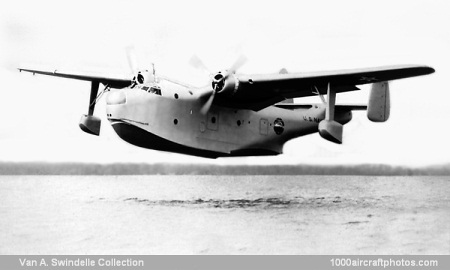12/31/2012. Having established itself as a builder of USN flying boats by producing the PM, P2M and P3M series to Naval Aircraft Factory designs, the Glenn L. Martin Company of Baltimore, Maryland, USA logically turned to the design of a new flying boat to succeed these earlier types.
Designed in 1937, the Model 162 continued the rivalry which had sprung up between Martin and Consolidated by challenging the latter company's PBY Catalina. A somewhat later design than the PBY, the Martin 162 was in due course to demonstrate a marked superiority of performance, and although it served in smaller quantities than the PBY during WW II, it continued to give important service for many years after 1945.
The Model 162 design featured a deep hull with a gull wing and two Wright Cyclone engines. To test the handling qualities of the design, Martin built a single-seat, quarter-scale model known as the Model 162A, and on June 30, 1937, the USN placed a contract for a single full-size prototype, to be designated XPBM-1. First flown on February 18, 1939, the XPBM-1 had 1,600 hp R-2600-6 engines and provision for nose and dorsal turrets plus additional gun positions at the waist and tail positions.
In addition to six guns, the XPBM-1 was designed to carry 2,000 lb (907 kg) of bombs or depth charges. It had retractable stabilizing floats under the wings and, as first flown, a flat tail plane with outrigged fins; later, dihedral was added to the tail plane, canting the fins inwards to give the Martin boat one of its most striking characteristics.
At the end of 1937 the USN ordered twenty production model PBM-1s, for which the name Mariner was eventually chosen, and a single XPBM-2 with extra fuel and provision for catapult launching. All these were completed by April 1941 and were similar to the XPBM-1 with dihedral on the tail plane. Most of the PBM-1s went into service during 1941 with VP-74, a merger of the former VP-55 and VP-56 squadrons, and in the same year the prototype went to the Aircraft Armament Unit at Norfolk NAS as the XPBM-1A for armament experiments.
Orders were placed with Martin for 379 PBM-3 Mariners on November 1, 1940, but these appeared, from April 1942 onwards, in several different versions. All Mariners from the PBM-3 model onward, however, had fixed, strut-braced wing floats and lengthened engine nacelles, the latter providing stowage for the bombs or depth charges.
The basic PBM-3 had R-2600-12 engines, and the variants included fifty unarmed PBM-3R transports with seats for twenty passengers, 274 PBM-3Cs with standardized US/British equipment, and 201 PBM-3Ds with R-2600-22 engines and improved armament and armor protection. Many of the PBM-3Cs and -3Ds carried search radar in a large housing above and behind the cockpit, and experience with the use of this radar led to development in 1944 of a long-range anti-submarine version, the PBM-3S. A total of 156 of the latter variant was delivered, with R-2600-12 engines.
A 1941 contract for 180 Mariners specified the PBM-4 version, which would have had R-3350-8 engines, but this development was not pursued. Instead, the XPBM-5 appeared in 1943 with 2,100 hp Pratt & Whitney R-2800-22 or -34 engines, and production contracts were placed for this variant in January 1944. The PBM-5, delivered from August 1944 to the end of the war, had eight 0.50 in (12.7 mm) machine guns and AN/APS-15 radar. The latter equipment was indicated by the PBM-5E designation, which was in practice not always used; some PBM-5S variants were also in service in the later forties, this designation indicating a change of equipment specifically for the anti-submarine role. Production totaled 631, with the last aircraft in this batch assigned for conversion to the prototype XP5M-1 Marlin.
Final Mariner development was an amphibian version, the PBM-5A, 36 of which had been built by the time production was completed in April 1949. The PBM-5A served primarily in the air-sea rescue role with the USN and USCG, replacing PBM-5G flying boats in the latter case.
